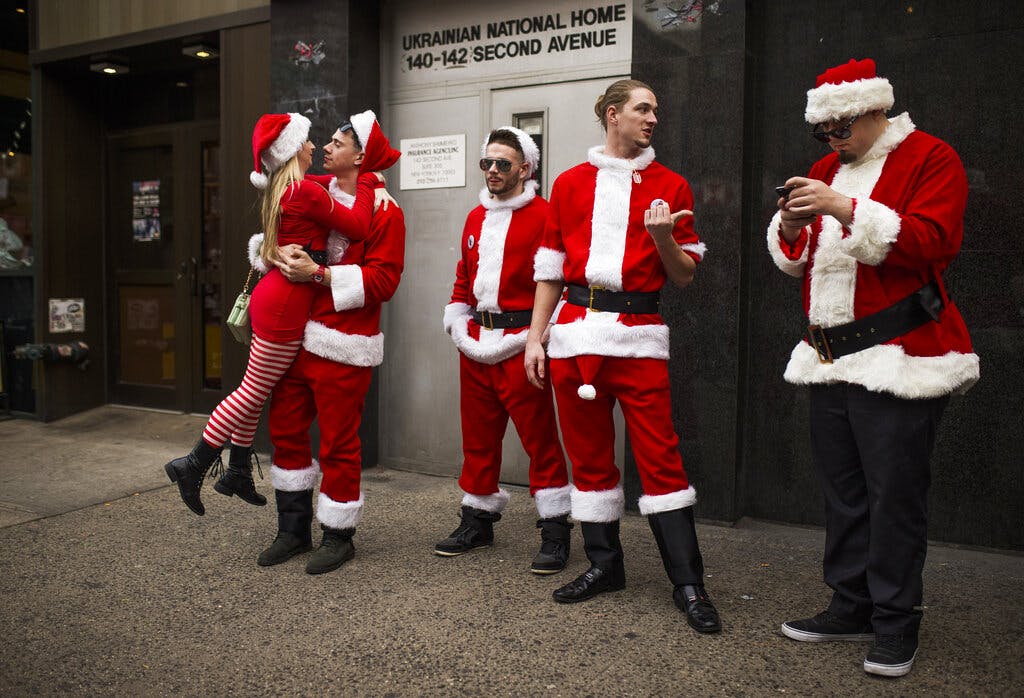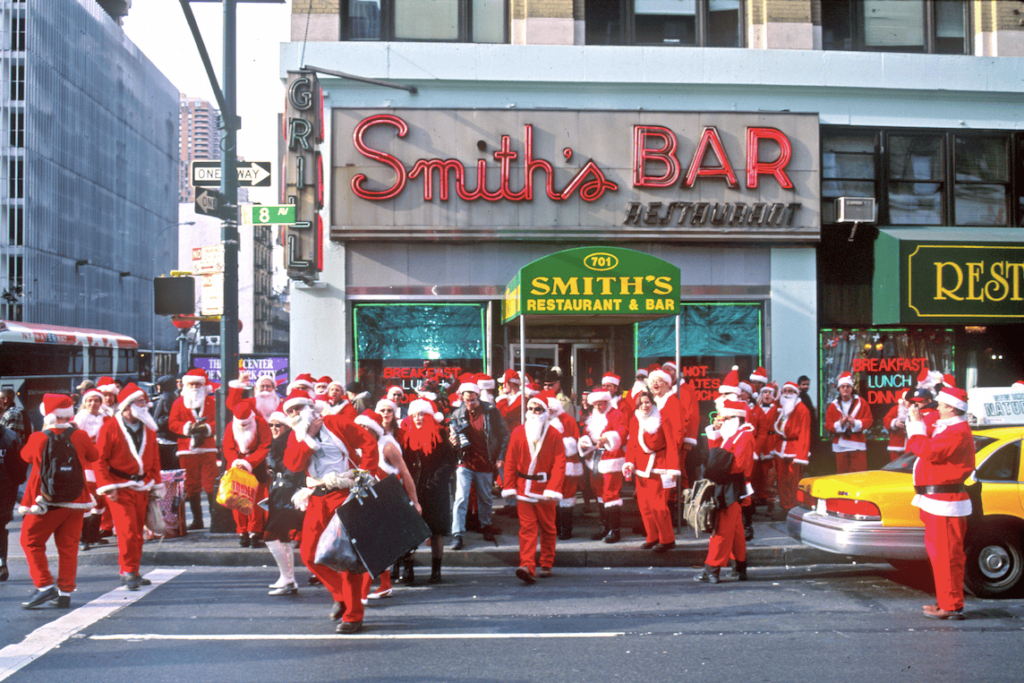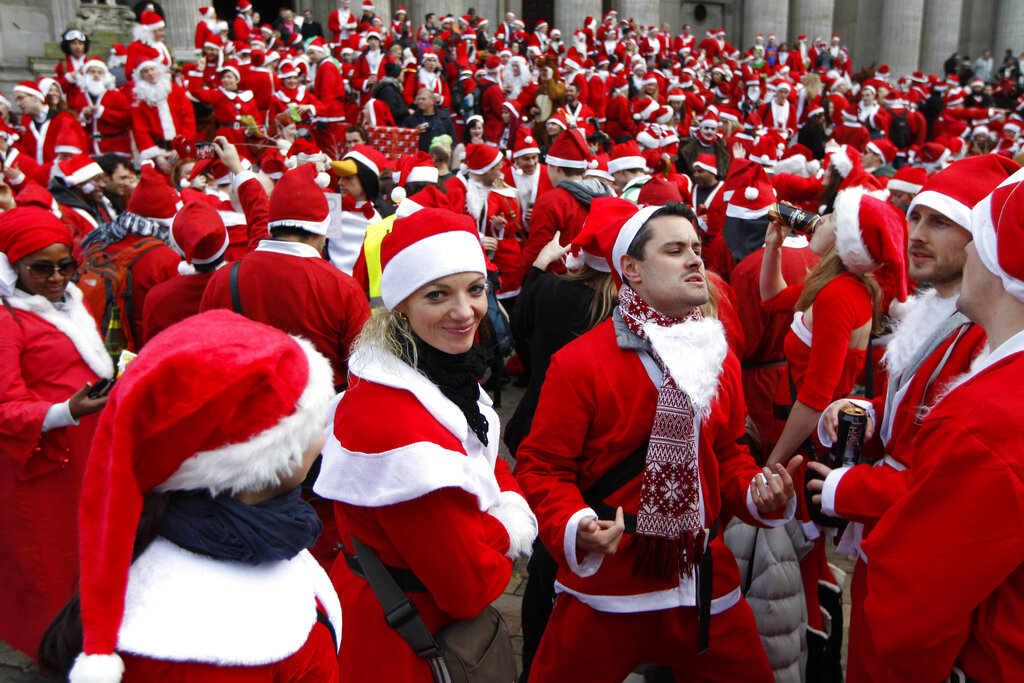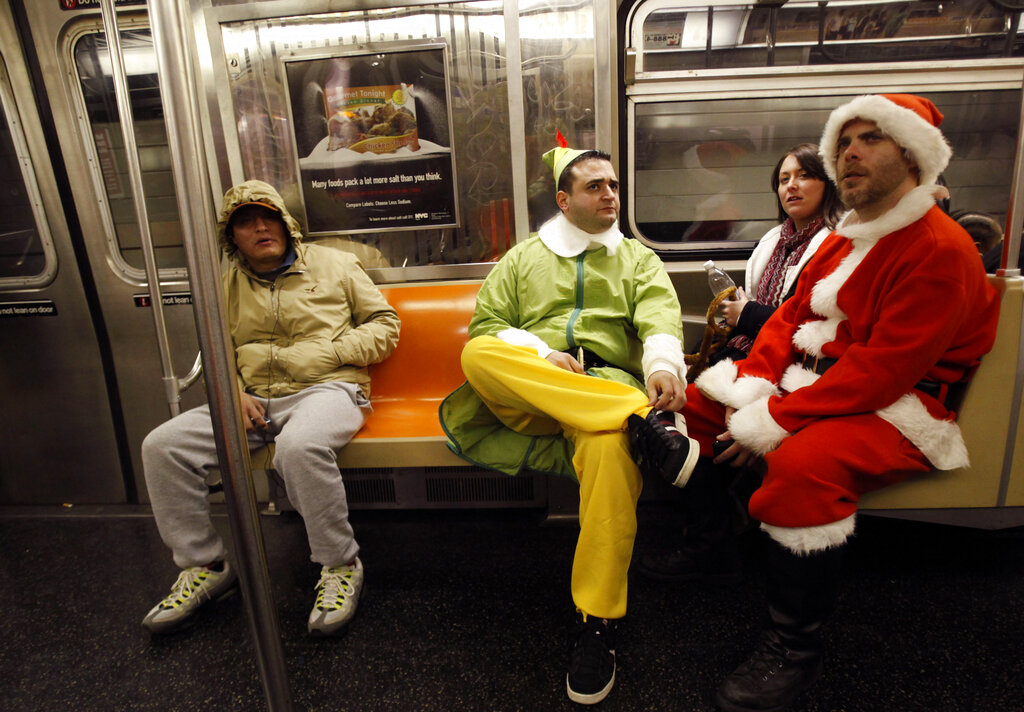Yes, Virginia, There Is a SantaCon
How else will New Yorkers be able to make glad the heart of young adulthood?

While New York City prepares for “SantaCon” this Saturday, the group of artists and dissidents that started the tradition is fast fading from memory.
New York City’s SantaCon is a yearly event dating back to the 1990s. In its modern form, it is, according to event organizers, “a charitable, non-political, nonsensical Santa Claus convention that happens once a year to spread absurdist joy.”
Once a year, tens of thousands of people dressed as Santa or holiday-adjacent figures like Saturday Night Live’s “the Great Hanukkah Harry” descend on Manhattan for a costumed bar crawl.
Over the years, the rowdiness and drunkenness of some Santas has given the event a mixed reputation, with Gothamist publishing a yearly “Best and Worst” of SantaCon article, local news sites publishing accounts of the preparations made by local officials, and the MTA banning alcohol on select train lines frequented by the Santas.

The Sun reached out to SantaCon NYC, and the group responded by saying that “Santa’s workshop is very busy this time of year” and that “the SantaCon organizers have met with the NYPD, community affairs, mayor’s office of Nightlife and receive[d] all permitting for our event.”
The Dionysian celebration that is SantaCon, however, has a secret history largely absent from the modern celebration. The first modern American SantaCon, dubbed “Santarchy” at the time, was held in 1994 at San Francisco, and a history of the event is recorded at Santarchy.com, a “global directory of SantaCon events.”
This “Santanailia” was originally organized by San Francisco’s Cacophony Society, a secret counter-cultural society that the authors of “Tales of the San Francisco Cacophony Society,” Carrie Galbraith and John Law, characterized as a “randomly gathered network of individuals united in the pursuit of experience beyond the pale of mainstream society.”
One of the founders of the society, Mr. Law, who was also involved in the early days of Burning Man, describes it as a heterodox and anarchic group of artists and pranksters that would organize zany events and art projects that attracted members like “Fight Club” author Chuck Palahniuk.
A McCook Daily Gazette article from December of 1993 describes one prank where society members held an “Uncan the Cranberries” protest in a shopping area during which the members urged shoppers to “save the free-range cranberry.”

A San Francisco Chronicle article from December of 1994 describes the first event in what would become SantaCon, where “20 Santa Clauses danced through the room” of what the article’s author, Pat Steger, described as the “one Cotillion debutante party that really [stood] out” that year.
The next year, the event grew, with the Cacophony Society rounding up the “usual suspects” and “guerilla artists.” One Santa, reporting as S. Cape Claus, described the scene.
“After a brief reading of their art riot act, the Santas hoisted white garbage sacks of toys, pulled on their hipflasks, fired up smokes, and plunged into the holiday crowd of shoppers counting down the days to Xmas,” S. Cape Clause wrote.
The events of the second SantaCon culminated in a mock-hanging of one Santa, Chad Mulligan, before the Santas scattered and took to their bus and made their getaway. S. Cape Clause reports that the buses were stopped by police. According to a police report the cops ordered some Santas to submit to legal detention, which the Santas “refused in an un-Christmaslike fashion.” Two of the Santas were arrested for allegedly vandalizing a store on Market Street. The rest went on to continue their night.
Mr. Law tells the Sun that, despite the rowdiness of the Santas, the group took care not to portray Santa in a negative light around children, saving stunts like the mock-hanging for close to midnight.
Mr. Law says that for him “it was about taking back the holiday, making it something that could be fun” after becoming disillusioned at any early age with the combination of consumerism, Christianity, and pagan traditions that is the modern tradition of Christmas.

He says that the modern incarnation of SantaCon is “a mixed blessing,” with the public nuisance of some Santas detracting from the charitable mission of some Santa events around the country. Mr. Law says he was “never in it for the money” and doesn’t make money from the modern SantaCon, which sprung from the early Santarchy days but which he is not affiliated with.
Mr. Law attended his first SantaCon at New York City since 1998 last year with another founder of Santarchy, Rob Schmidt, for director Seth Porges’s upcoming documentary on the topic.
“It seems to me that for the most part it’s kids coming in from the burbs and they get drunk and stupid and have fun,” Mr. Law says. “The one day when the kids come in and annoy the hipsters, I think that’s funny actually.”
The roots of SantaCon go back further than one prank-filled December night in 1994. Mr. Law says that the original idea for SantaCon came from the Danish anarchist group, Solvogon — meaning “chariot of the sun” — a group which has all but disappeared but was featured in a 1977 Mother Jones article.
Mr. Law tells the Sun that the event was inspired, in part, by this group of Danes who staged a protest at Danish department stores where members dressed as Santa and handed children toys, telling them that Santa and the store wanted them to have it.
The article was reprinted in the “Nooseletter” of another San Francisco secret society, the Suicide Club. One Cacophony Society member, Mr. Schmidt, was inspired by the events recounted in the article to do an event of his own.
“Cacophony was a wonderful group of artists and lawyers and blue-collar workers,” Mr. Schmidt says of the Cacophony Society. “We didn’t really have an age — there were a lot of older people in the group.”
Mr. Schmidt tells the Sun that “the beautiful thing about Cacophony is that everybody chipped in” and that the idea came to him while he was making costumes for another event.
“I was at my friend’s house making costumes and on her floor was a postcard of Santas playing pool and I said to her ‘We’ve got to do this,’” Mr. Schmidt says. “I went to a Cacophony meeting and people said ‘That’s the worst idea ever. What about the kids?’”
After putting out the word in the organization’s newsletter, however, four people showed up to organize the first Santarchy, which would end up featuring 38 Santas.
“I ordered the Santa suits from a company called Oriental Trading Company,” Mr. Schmidt says. “Back then we got cheap Santa suits for just over $20 each.”
Mr. Schmidt added that the group caught a few breaks in organizing the event, with the Santa suits showing up on the day of the event in 1994. A friend of Mr. Schmidt’s who worked at a bus company also secured a bus for just the price of gasoline, meaning the Santas had a sleigh for the night.
Throughout the 1990s SantaCon caught fire, spreading to Portland in 1996, Los Angeles in 1997, and New York City in 1997. At Portland in 1996, police were tipped off and met the Santas at the airport.
“The Police Bureau has received information of a possible disturbance planned for the Portland area on Saturday Dec. 14, 1996,” reads an interoffice police memo from that year. “The individuals involved in these disruptive activities will be wearing Santa suits.”
In 2003, the first “Santarctica” occurred in Antarctica, which one attendee described as “The largest congregation of Santas the furthest from the North Pole.”
Looking back on nearly 30 years of Santarchy, Mr. Schmidt, who stepped away from organizing Santa-related events in the mid-1990s, says his favorite thing about the event throughout the years is “the creativity that happens” when people get together to make costumes and organize events.
“You look at a kid who’s out of college and he goes out there and does that — the ideas that come out of it — the kid realizes he can get his friends together and make his own thing,” Mr. Schmidt says.
“Once they meet people at SantaCon they now have their own group of friends and can decide to do their own event,” Mr. Schmidt added. “That’s what I like about it. People realize they can do things.”

